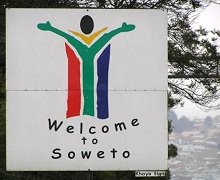 SOuth WEstern TOwnships – Soweto, my dear friend Paul Mbenenge’s neighbourhood, may be the largest black city in Africa. It gives you an idea about how 3,5 million people got its fame during the "apartheid" years. The Picture 'Madonna and Child of Soweto' painted by Larry Scully (1922-2002) in the Regina Mundi Catholic church gives experience of the role of the church during the struggle years. Death and attacks to faithful Christians were held inside it. She is a black African Lady with an also black Child, as Czestochowa, Pilar or Montserrat. Behind both, an eye of Our Lady appears, with a view of Soweto painted on it, so as She watches the town in her pupil.
SOuth WEstern TOwnships – Soweto, my dear friend Paul Mbenenge’s neighbourhood, may be the largest black city in Africa. It gives you an idea about how 3,5 million people got its fame during the "apartheid" years. The Picture 'Madonna and Child of Soweto' painted by Larry Scully (1922-2002) in the Regina Mundi Catholic church gives experience of the role of the church during the struggle years. Death and attacks to faithful Christians were held inside it. She is a black African Lady with an also black Child, as Czestochowa, Pilar or Montserrat. Behind both, an eye of Our Lady appears, with a view of Soweto painted on it, so as She watches the town in her pupil. 
Jo’burg’s infamous black suburb, Soweto, long a center of anti-apartheid activity, is the most highly populated black urban residential area in South Africa, with nearly a million people. Not surprisingly then, it leads the way in politics, fashion, dance and music, among other things. Sowetans have adapted to their own culture and come up with a new kind of sophistication.
Now it is a distinct lack of space created by borders in years past gives way to new neighbourhoods, with larger homes and a Southern California flavour, on the outskirts and tastes, as my friend Paul Mbenenge says. The new place serves as a model for upward mobility and work ethic, rather than a source of jealousy for those a block away living in homes a fraction of the size. Not matter about it.
 There are 'informal' shacks built in packed places with an occasional public get together. Stopping and walking through one of these, we saw homes with two rooms -kitchen and bedroom-, a daycare center with a church service held outdoors, singing acapella in Zulu. Happy people and smiling guys.
There are 'informal' shacks built in packed places with an occasional public get together. Stopping and walking through one of these, we saw homes with two rooms -kitchen and bedroom-, a daycare center with a church service held outdoors, singing acapella in Zulu. Happy people and smiling guys.A drive through the Soweto
 market offers second hand clothing laid out for display. The west side of Soweto, shows Desmond Tutu's home, Winnie Mandela's home, Hector Pieterson museum, on the site of his death in 1976, shot during the student uprising that sparked 18 years of unrest, sanctions against South Africa. During the demonstrations, the day Pieterson was shot, and knew many of the leaders of the black consciousness movement . The history of the events is told with personal knowledge and it brings back memories of difficult days, a powerful experience, and a reminder of how far South Africa has come from there nowadays.
market offers second hand clothing laid out for display. The west side of Soweto, shows Desmond Tutu's home, Winnie Mandela's home, Hector Pieterson museum, on the site of his death in 1976, shot during the student uprising that sparked 18 years of unrest, sanctions against South Africa. During the demonstrations, the day Pieterson was shot, and knew many of the leaders of the black consciousness movement . The history of the events is told with personal knowledge and it brings back memories of difficult days, a powerful experience, and a reminder of how far South Africa has come from there nowadays.

No hay comentarios:
Publicar un comentario